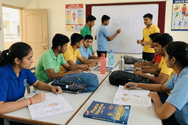
Never Miss an Exam Update
CBSE Class 12th Political Science Chapter 3 - Contemporary South Asia Important Questions with Answers have been provided in this article for you to score incredible marks in the upcoming exam. Since the CBSE Class 12 exam 2025 is around the corner, by now you should go through some of the important questions from Chapter 3 - Contemporary South Asia. The chapter addresses the issues of the regions like Bangladesh, Bhutan, India, the Maldives, Nepal, Pakistan and Sri Lanka through research and analysis which is multi-disciplinary as well as cross-regional. Contemporary South Asia deals with the study of current social, political, and economic issues within the region, including the South Asian countries focusing on contemporary challenges and developments in the region through a multidisciplinary lens, analyzing topics like politics, society, culture, economics, and regional cooperation. The important topics that are covered in this chapter are India and its neighbours, Peace and cooperation, Environment and natural resources, External influence, Social and political issues, Economic development, Cross-border migration and so on.
The CBSE Class 12 Political Science syllabus 2024-25 has been divided into two parts: Part A and Part B. Part A deals with Contemporary World Politics that mainly talks about the political landscape beyond India's borders. Part B focuses on Politics In India Since Independence that is about the political developments in India after it became independent in 1947. Contemporary South Asia is the third chapter of Part A, Contemporary World Politics. Total marks allotted for this chapter is 6 marks. There are a total of 7 chapters in Part A. Prepare thoroughly with the most important questions of CBSE Class 12th Political Science Chapter 3 - Contemporary South Asia. You can first cover the CBSE Class 12th Political Science syllabus to understand the key topics and then start solving the CBSE Class 12th Political Science Chapter 3 - Contemporary South Asia Important Question to get a better understanding of your preparation level. Start practicing now.
Are you feeling lost and unsure about what career path to take after completing 12th standard?
Say goodbye to confusion and hello to a bright future!

Was this article helpful?


































